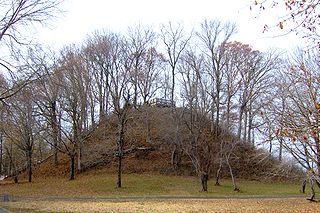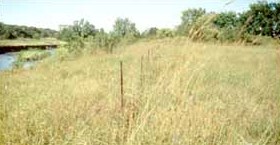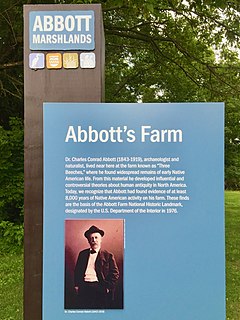Related Research Articles

The Pinson Mounds comprise a prehistoric Native American complex located in Madison County, Tennessee, in the region that is known as the Eastern Woodlands. The complex, which includes 17 mounds, an earthen geometric enclosure, and numerous habitation areas, was most likely built during the Middle Woodland period. The complex is the largest group of Middle Woodland mounds in the United States. Sauls' Mound, at 72 feet (22 m), is the second-highest surviving mound in the United States.

Fort Ancient is a Native American earthworks complex located in Washington Township, Warren County, Ohio, along the eastern shore of the Little Miami River about seven miles (11 km) southeast of Lebanon on State Route 350. The site is the largest prehistoric hilltop enclosure in the United States with three and one-half miles (18,000 ft) of walls in a 100-acre (0.40 km2) complex. Built by the Hopewell culture, who lived in the area from the 200 BC to AD 400, the site is situated on a wooded bluff 270 feet (82 m) above the Little Miami. It is the namesake of a culture known as Fort Ancient who lived near the complex long after it was constructed.

Buildings, sites, districts, and objects in Delaware listed on the National Register of Historic Places:
List of the National Register of Historic Places listings in Kent County, Delaware
This is a list of properties on the National Register of Historic Places in northern New Castle County, Delaware.

Indian Village State Preserve, or the Wittrock Indian Village State Preserve, is a state archaeological preserve near Sutherland, Iowa. The 6-acre (2.4 ha) property preserves the Indian Village Site (13OB4), a prehistoric fortified village of the Mill Creek culture. It was declared a National Historic Landmark in 1964, and made a state preserve in 1968. It is located east of Sutherland, south of 455th Street and west of Yellow Avenue. Access to the preserve requires crossing private land.

The Abbott Farm Historic District is a National Historic Landmark archaeological site in New Jersey. It is the largest known Middle Woodland village of its type on the East Coast of the United States. Significant evidence suggests that the Delaware River floodplain was occupied by Paleoindian people for a long period. It was inhabited between 500 BC and 500 AD. It has been a source of controversy and debate around early development.

The Paisley Caves complex is a system of four caves in an arid, desolate region of south-central Oregon, United States north of the present-day city of Paisley, Oregon. The caves are located in the Summer Lake basin at 4,520 feet (1,380 m) elevation and face to the west in a ridge of Miocene and Pliocene era basalts mixed with soft volcanic tuffs and breccias, from which the caves were carved by Pleistocene-era waves from Summer Lake. One of the caves may contain archaeological evidence of the oldest definitively-dated human presence in North America. The site was first studied by Luther Cressman in the 1930s.

Bristol is an unincorporated community in Anne Arundel County, Maryland, United States. Jug Bay Wetlands Sanctuary and the colonial town of Pig Point are on the Patuxent River waterfront portion of Bristol. Pig Point saw War of 1812 action and was the county's largest steamboat port on the Patuxent in the mid-19th century. Pig Point is a very significant Native American Early Archaic Period archaeological site.

The Book Site is an archaeological site in Juniata County, Pennsylvania, United States. Consisting of the remnants of a burial mound and a prehistoric village, the site lies on both sides of Camp Resort Road in Beale Township, near the community of Beale.
The Carey Farm Site (7K-D-3) is a prehistoric Native American archaeological site in central Kent County, Delaware, near Dover. The site, located along the St. Jones River, encompasses what is believed to be a major seasonal base camp from the Woodland Period. Ceramics dating to 200 CE have been found at the site.
The Byfield Historic District encompasses the remains of an early colonial community in eastern Kent County, in the U.S. state of Delaware. The district includes four separate archaeological sites, each of which have been associated with early English settlers of the area. The site designated K-929 is the location of a brick kiln, which documentary evidence suggests was associated with Daniel Jones, the first settler in the area. K-917 is speculated to be associated with William Rodney, who married Jones' daughter. K-916 is a site that may have been a slave residence, and K-890 is believed to be the site of one of the homes of Caesar Rodney, Sr., the father of Delaware Revolutionary War leader Caesar Rodney. The only 19th century structure in the district is the S. A. Sipple House.
St. Jones Neck is a geographic region of eastern central Kent County, Delaware, United States, with a rich prehistory and colonial history. Originally known just as Jones Neck, it is bounded on the west by the St. Jones River, on the north by Little Creek, and on the east by Delaware Bay. The area consists of low rolling hills that do not rise very much above sea level, interspersed with bodies of fresh and salt water. Streams are headed by marshes, and there are tidal marshlands along the bay. The neck has pockets of woodland which are concentrated near the freshwater marshes and tributaries. Land use in the neck is at present predominantly agricultural.
The Wilgus Site is a prehistoric Native American camp site in coastal Sussex County, Delaware, near Bethany Beach. The site is located along a now-inundated tributary of the Indian River, with the main living area of the camp on top of a low knoll. Shell middens and refuse heaps, some as much as 8 metres (26 ft) in diameter, are located down the slopes of the knoll. Evidence of the site indicates it was occupied during the Adena culture during the Early Woodland Period.
The Island Field Site (7K-F-17) is a major archaeological site in Kent County, Delaware, United States. The site is located in South Bowers, just south of the Murderkill River near where it empties into Delaware Bay. The site was a major prehistoric Native American village site, which was most notable for its cemetery. The site was first identified in the 1920s during road work, and was excavated in the 1950s-60s, after which the area was eventually built up to include a museum. In 1986 members of the local Nanticoke tribe protested the display and removal for research of burial remains at the site.

The Clyde Farm Site (7NC-E-6) is a prehistoric archaeological site in rural New Castle County, Delaware. Its main features are remnants of a pit-house, storage area, and hearth, dating to c. 1000 BCE. Another area where stone tools were produced was also identified during excavations in 1984. The site has been known, and the subject of both amateur and professional archaeological interest, since at least the 1930s. It is described as being located near the fall line of a waterway and also an estuarine area.
The Hell Island Site (7NC-F-7) is a prehistoric archaeological site located near Odessa, Delaware. The site is a type site for a class of ceramics found at other sites in the region. Artifacts recovered from the site during excavations in 1965 yielded then-distinctive tempered pottery with cordmarking on the interior and exterior, as well as evidence of occupation of the site from the Archaic to the Late Woodland Period.
7K-F-4 and 7K-F-23 are a pair of archaeological sites in southern Kent County, Delaware, near the town of Milford. Both are Early Woodland Period Native American camp sites, at which ceramics have been found.
The Dill Farm Site (7K-E-12) is a prehistoric archaeological site in Kent County, Delaware, near the town of Sandtown. The site located in a formerly swampy area, has yielded dates of 500 BC and 8000 BC. Carey Complex ceramics have also been found at the 55-acre (22 ha) site.
The Hughes Early Man Sites are a complex of prehistoric archaeological sites in central Kent County, Delaware, near the town of Felton. The complex includes six areas of concentrated finds located on well-drained knolls. Finds include a Clovis projectile point, a collection of notched projectile points, bifaces, and remnants of stone tool-making activities.
References
- Thomas, Ronald; et al. (Spring 1975). "Environmental Adaption on Delaware's Coastal Plain". Archaeology of Eastern North America (Volume 3). JSTOR 40914140.
- 1 2 "National Register Information System". National Register of Historic Places . National Park Service. July 9, 2010.
- ↑ Thomas, et al, pp. 70-71
- ↑ Thomas, et al, pp. 72-76
- ↑ Thomas, et al, p. 77

